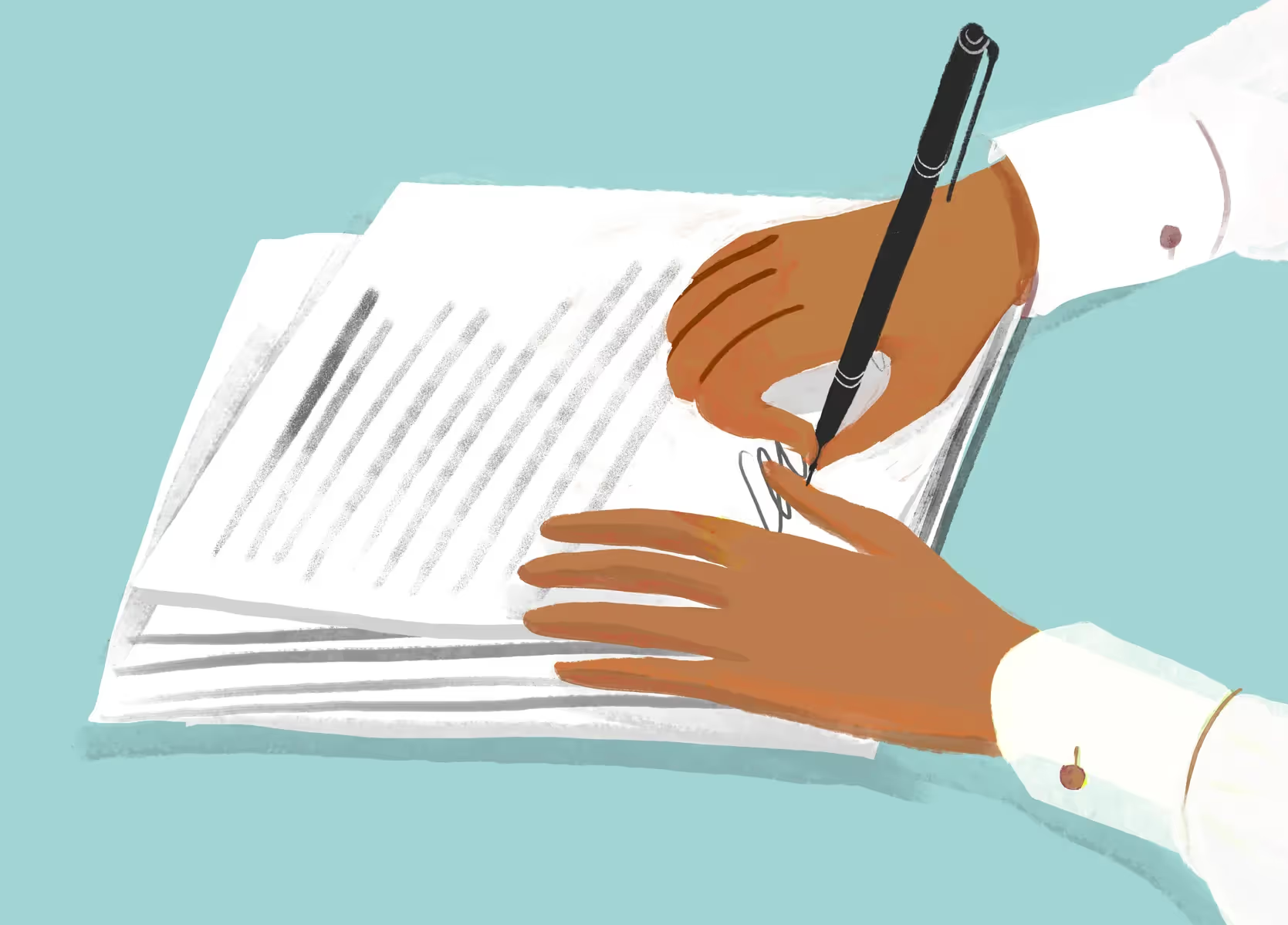
Procurement management: A complete guide
Learn how procurement management optimizes supply chains with this guide.

If you’ve ever navigated a maze of outdated processes, unreliable suppliers, and skyrocketing costs, you aren’t alone. That’s the reality many procurement professionals face.
Procurement management is the art of turning that chaos into order. It’s about getting the right goods and services at the right time for the right price. But it's more than just acquiring business assets; it's about optimizing your business’s operations and driving bottom-line results.
In this guide, we'll break down the nine-step procurement process, explore the role of a procurement manager, and reveal why effective procurement management is essential for any company.
What is procurement management?
Procurement management, sometimes known as the "source-to-settle process," is the process of acquiring the goods and services an organization needs to operate and grow. It involves a series of steps, from identifying needs to managing supplier relationships.
A strong procurement management plan typically includes the following functions:
- Accounts payable: The accounts payable department is responsible for verifying and paying invoices from suppliers.
- Requisitioning: Requisitioning is the process of creating and submitting purchase requests for goods and services.
- Purchasing: The purchasing function involves buying goods and services from suppliers, including negotiating prices, terms, and conditions.
- Resource planning: Procurement teams ensure their organization has the necessary resources, staff, budget, and technology to successfully support their procurement process.
- Contract management: Developing, negotiating, and managing contracts with suppliers ensures the organization's needs are met and that the supplier is held accountable for fulfilling their obligations.
- Supplier sourcing and evaluation: Procurement managers help find and evaluate potential suppliers based on their ability to meet the organization's needs, financial stability, and track record.
Though terms like “sourcing,” “purchasing,” and “procurement” are often used interchangeably, there are nuances among them.
Sourcing management is viewed as more strategic, focusing on finding the right supply partners, while purchasing and procurement deal with operational aspects of acquiring goods and services.

Why is procurement management important?
Just like a car needs the right fuel to run smoothly, a business needs the right resources to operate effectively. Procurement management is the fuel that keeps your business running, ensuring you have the necessary goods and services in place to achieve your goals.
Think of it as optimizing every dollar you spend. By finding the best deals, streamlining processes, and keeping a close eye on supplier relationships and operations, you can optimize your cash flow and boost profits.
Effective procurement management can give your business a competitive edge in more ways than one. A well-managed procurement process can help you move faster, respond to changes in the market, and negotiate better deals with suppliers.
The benefits of optimized procurement management
Optimizing procurement management is akin to setting the gears of a complex machine in perfect alignment. When each part operates in harmony with the others, the entire procurement management system runs smoothly, efficiently, and to its maximum potential.
See the difference a well-managed procurement process can make:
- Cost savings: Every dollar saved in procurement is a dollar that can be invested elsewhere in the business. Optimized procurement management opens the door to significant cost reductions through process automation, data analytics, and attentive record-keeping.
- Improved efficiency: A more efficient procurement process means more productive employees. With fewer mistakes to fix, you’ll have more time to focus on other important tasks.
- Streamlined contract lifecycles: Optimizing procurement contract lifecycles by centralizing information, automating routine tasks, and providing tracking tools can help your company improve efficiency, reduce errors, and ensure compliance with contract terms.
- Improved supplier relationships: Procurement management strengthens supplier relationships by encouraging open communication, trust, and collaboration to improve operations. This, in turn, leads to less stress on your procurement teams and the ability to negotiate better deals over time.
- Enhanced risk management: By finding and fixing potential problems in the supply chain, like supplier disruptions, quality issues, and financial losses, effective procurement management can help businesses protect their operations.
9 steps of the procurement process
The steps in the procurement process are largely the same across most companies, though they might change a little depending on your company’s unique needs. Let’s break down the nine main steps:

1. Identify business needs
The first step in the purchasing process is figuring out exactly what your business needs to grow. This could be anything from simple office supplies to an ongoing relationship with a marketing agency. Gathering comprehensive details like order history, quality specifications, delivery times, and budget constraints is essential.
For example, a manufacturing firm might check its inventory levels and production schedules to figure out what materials they need before they even start looking for suppliers.
2. Create a purchase requisition
Once you’ve identified your needs, you’ll need to compile a formal purchase requisition detailing the order. Submit this document to the purchasing department for approval, making sure that the proposed purchase aligns with the company’s budget and operational strategy.
3. Assess vendors
After your purchase requisition is approved, it’s time to find the best suppliers. This is a great opportunity to expand your list of vendors and compare options based on price, quality, reliability, and production capacity. Building strong relationships with your suppliers is a key part of good procurement practices.
4. Finalize contract terms
With potential vendors identified, the next step is to finalize the terms of your procurement contracts. This involves negotiating the best possible price and delivery terms. It’s important to be clear about what you expect from the supplier at this stage, including specific delivery timelines.
5. Complete the purchase order
Once you and your supplier have agreed on the contract terms, a purchase order is generated, officially initiating the order fulfillment process. This document formalizes the transaction with providers and sets the wheels in motion for delivery.
6. Expedite your purchase (optional)
Sometimes, it may be necessary to rush a purchase order to meet urgent needs. In these cases, it's important to keep a close eye on the delivery schedule and deal with any delays right away to ensure you get what you need on time.
7. Three-way match all goods and/or services
Once you receive the order, do a three-way match. This means comparing the invoice, the purchase order, and the goods and services you received. This step ensures that you got what you ordered.
8. Approve payment
Once you’ve confirmed that the order contains everything you expected, you can approve the invoice for payment. Paying on time helps build good relationships with your suppliers and ensures you’re holding up your side of the contract.
9. Update records
The final step is to carefully document the entire purchasing process for future reference, including details about supplier interactions, purchase orders, and payments. This information is important for audits, improving your procurement strategy, and scaling your business.
Using automated procurement management software can significantly simplify this process with robust record-keeping capabilities for large and complex metrics.
5 ways to improve your procurement management system
Improving your procurement management system can help you save money, improve efficiency, and reduce risk. There are five main ways to upgrade your procurement strategy.
1. Establish strong procurement policies
Solid procurement policies are essential for any organization that wants to improve efficiency, reduce costs, and manage risk. Procurement policies provide a framework for decision-making and help make sure all purchasing activities are conducted consistently and transparently.
A few good policies to have in place include:
- Supplier code of conduct: Outlines ethical and responsible business practices that suppliers must follow, like fair labor practices, environmental protection, and compliance with relevant laws and regulations
- Conflict of interest policy: Prohibits employees from engaging in activities that could compromise their objectivity in procurement decisions, such as having personal relationships with suppliers or accepting gifts from them
- Sustainability policy: Defines your organization's commitment to sustainable sourcing and procurement practices, including reducing its environmental impact, supporting fair trade, and promoting social responsibility
- Data privacy and security policy: Establishes guidelines for protecting sensitive data during procurement activities, like customer information, supplier data, and financial records
2. Use a procurement orchestration platform
Procurement teams, it's time to ditch the old-school centralized platforms and embrace the future of procurement: orchestration.
Traditional centralized procurement platforms can be rigid and difficult to customize, limiting innovation and adaptability. Instead of forcing everyone to use a single, monolithic platform, procurement orchestration allows teams to use their preferred tools (like Jira, Asana, or IronClad) while coordinating and automating the overall procurement workflow.
This approach offers a number of benefits, like:
- Enhanced user experience: Your team gets to work in tools they already love, boosting productivity and morale.
- Increased flexibility: Adapt to changing business needs without breaking a sweat.
- Improved collaboration: A centralized workflow fosters effortless communication and collaboration across teams and departments.
- Streamlined processes: Say goodbye to tedious to-dos — procurement orchestration can automate tasks like generating purchase orders, sending notifications, undating records, and more.
- Enhanced Visibility: Get real-time insights into every step of the procurement process.
- Better decision-making: Make smarter choices with actionable analytics.
3. Integrate with other ERP systems
Your procurement platform should integrate with other systems your organization uses to create a seamless and efficient workflow. This means data should be able to flow freely between your procurement platform and other systems, such as your ERP, CRM, and accounting systems.
For example, your procurement platform should be able to automatically pull in data from your ERP system, like inventory levels, production schedules, and supplier contracts. This can help you identify procurement needs and select the best suppliers.
4. Automate manual tasks
Procurement automation refers to the use of technology to automate the procurement process. Leaving tedious manual work to procurement automation can help your team focus on more important things, like finding ways to save money and building good relationships with suppliers.
Procurement automation is used to automate tasks like generating purchase orders, tracking invoices, and managing contract lifecycles. This helps reduce errors and save time. Procurement automation can also help improve data accuracy and visibility, which translates to better decision-making based on accurate and up-to-date information.
5. Assess performance
Perfecting your procurement strategy is a never-ending process, which is why you need metrics in place to measure the performance of your procurement activities. Procurement KPIs can help pinpoint areas for improvement, track progress toward company goals, and demonstrate the value of procurement to the organization.
There are dozens of procurement KPIs organizations can use, like:
- Spend under management: The percentage of total spending managed through the procurement process
- Savings achieved: The amount of money saved through procurement initiatives
- Supplier performance: The performance of suppliers in terms of quality, delivery, and cost
- On-time delivery: The percentage of orders delivered on time
- Defect rate: The number of defective items or services received
- Invoice accuracy: The accuracy of invoices from suppliers
What to look for in procurement management software
Choosing the right procurement software is like picking the perfect pair of jeans: It's all about finding the best fit for your business. When you're evaluating options, keep these key features in mind:
- Orchestration capabilities: The best software can orchestrate and automate complex procurement workflows, integrating with various tools and systems to streamline processes and improve efficiency.
- Integrations: Your procurement software should seamlessly integrate with other systems, like your ERP, CRM, and accounting software, to create a streamlined workflow.
- Advanced analytics: Look for software with robust analytics tools that can provide insights into spending patterns, supplier performance, and cost savings opportunities.
- Budget controls: Ensure the software offers features to set spending limits, track budgets, and prevent unauthorized purchases.
- Vendor cards: A vendor card system can help you store and manage information about your suppliers, like contact details, certifications, and performance history.
- Smart automation: Look for software that can automate repetitive tasks, like generating purchase orders, tracking invoices, and managing contracts, saving you time and reducing errors.
- Cloud-based access: Cloud-based software offers flexibility and accessibility, so you can access your procurement data from anywhere with an internet connection.
- Supplier management tools: The software should provide tools for managing supplier relationships, including performance evaluations, communication, and contract management.
- Accounts payable support: Look for software that can help you automate accounts payable processes, such as invoice approval, matching, and payment.

Streamline your procurement management with Zip
Zip is the next-generation platform designed to elevate your procurement management to new heights. By incorporating Zip into your procurement strategy, you not only streamline your procurement process but also unlock the potential for significant operational improvements and cost savings.
Ready to transform your procurement management and drive your business forward? Request a demo and discover the power of Zip for yourself.

Maximize the ROI of your business spend

Enter your business email to keep reading



























.webp)




















.avif)













.avif)









.webp)





.avif)












.avif)
